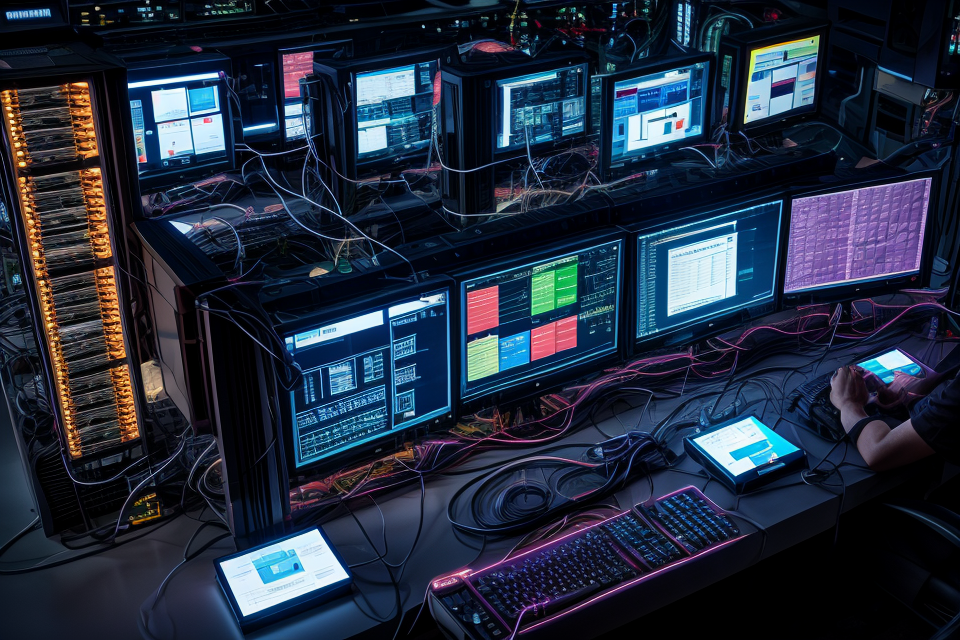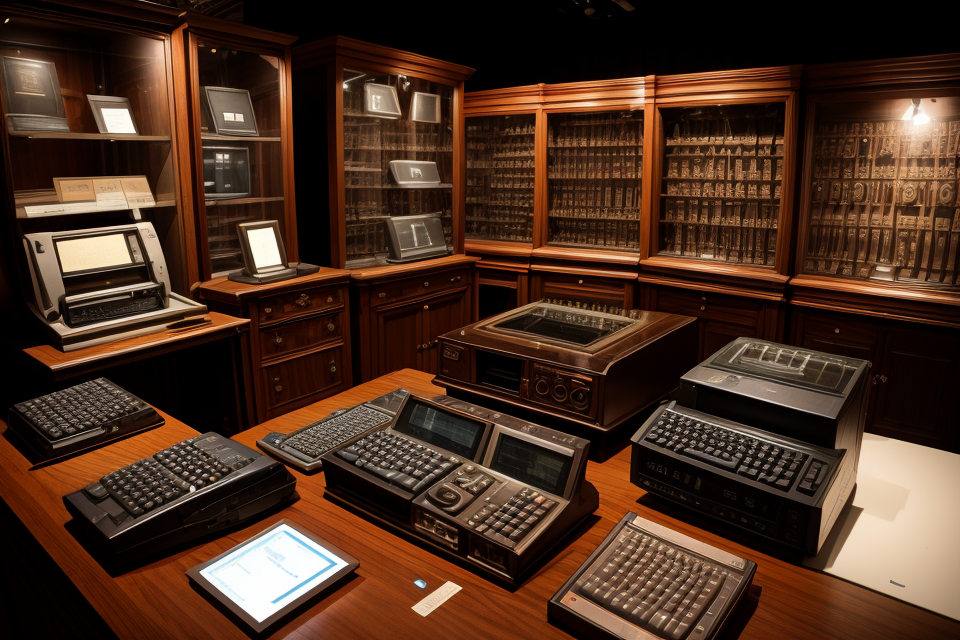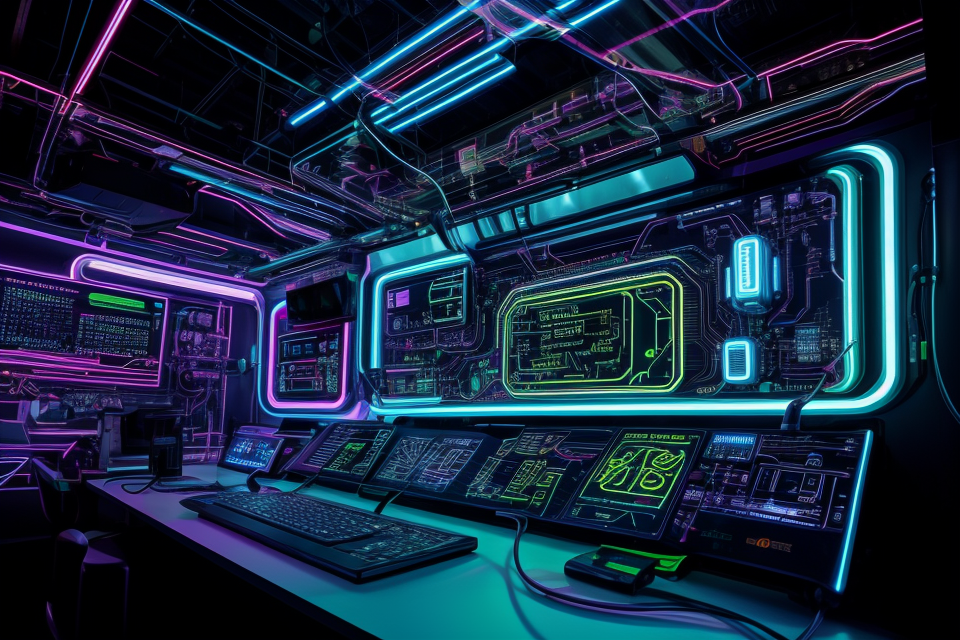
In today’s fast-paced digital world, computers have become an integral part of our lives. They have revolutionized the way we work, communicate, and even entertain ourselves. But have you ever wondered what gives computers their power? What enables them to perform such complex tasks with ease?
This comprehensive guide aims to explore the various factors that contribute to the power of computers. From the central processing unit (CPU) to the graphics processing unit (GPU), we will delve into the different components that make up a computer and how they work together to harness its potential.
We will also discuss the role of software in enhancing the power of computers, as well as the impact of technological advancements on the computing industry. By the end of this guide, you will have a better understanding of what gives computers their power and how to harness it to its fullest potential. So, get ready to embark on a journey to discover the secrets behind the power of computers!
Understanding the Basics of Computer Power
What is Computer Power?
Computer power refers to the ability of a computer system to perform tasks efficiently and effectively. It is determined by a combination of factors, including the processor, memory, storage, and input/output devices.
- Processor: The processor, also known as the central processing unit (CPU), is the brain of the computer. It executes instructions and performs calculations at lightning-fast speeds. The more powerful the processor, the more complex tasks it can handle.
- Memory: Memory, or random access memory (RAM), is where the computer stores data temporarily for quick access. The more RAM a computer has, the more programs it can run simultaneously without slowing down.
- Storage: Storage refers to the permanent storage of data on the computer, such as a hard drive or solid-state drive. The more storage a computer has, the more files and programs it can store.
- Input/Output Devices: Input/output (I/O) devices, such as a keyboard, mouse, and monitor, allow the user to interact with the computer and view the results of its processing. The quality and speed of these devices can impact the overall performance of the computer.
Understanding the components that contribute to computer power is essential for choosing the right computer for your needs and getting the most out of your technology investment.
The Central Processing Unit (CPU)
The Central Processing Unit (CPU) is the brain of a computer. It is responsible for executing instructions and performing calculations. The CPU is a complex electronic circuit that consists of multiple transistors, diodes, and other components.
Factors that affect CPU performance:
- Clock speed: The clock speed of a CPU determines how many instructions it can execute per second. A higher clock speed means a faster CPU.
- Number of cores: The number of cores a CPU has determines how many tasks it can perform simultaneously. A CPU with more cores can perform more tasks at once, making it more powerful.
- Cache size: The cache is a small amount of memory that is used to store frequently accessed data. A larger cache size means that the CPU can access data more quickly, which can improve performance.
- Architecture: The architecture of a CPU determines how it performs calculations. Different architectures are optimized for different types of tasks, so the choice of architecture can affect performance.
- Manufacturing process: The manufacturing process used to create a CPU can also affect its performance. CPUs created using more advanced manufacturing processes are generally more powerful than those created using older processes.
Random Access Memory (RAM)
Random Access Memory (RAM) is a crucial component of a computer’s hardware that plays a significant role in determining its overall performance. It is a type of memory that is used to temporarily store data and instructions that are currently being used by the computer’s processor. RAM’s role in computer power cannot be overstated, as it directly impacts the speed at which the computer can process information.
Factors that affect RAM performance include:
- Size: The amount of RAM installed in a computer directly affects its performance. In general, the more RAM a computer has, the faster it can process information.
- Speed: The speed at which RAM operates is also an important factor in determining its performance. RAM is typically measured in megahertz (MHz), with higher speeds resulting in faster performance.
- Capacity: The capacity of RAM refers to the amount of data it can store. In general, the higher the capacity of RAM, the more data the computer can store temporarily, which can improve performance.
- Usage: The way in which RAM is being used can also impact its performance. For example, if a computer is running multiple applications at the same time, it may require more RAM to operate efficiently.
In conclusion, RAM is a critical component of a computer’s hardware that directly impacts its performance. Factors such as size, speed, capacity, and usage can all affect the performance of RAM, and understanding these factors can help users optimize their computer’s performance.
Hard Drive or Solid State Drive (HDD/SSD)
Computer power is heavily reliant on the performance of its storage devices. Hard drives or solid state drives (HDD/SSD) play a crucial role in determining the speed and efficiency of a computer. In this section, we will delve into the details of HDD/SSD and the factors that affect their performance.
Role of Storage in Computer Power
Storage is a critical component of a computer’s power as it holds all the data that the computer uses to operate. This includes the operating system, applications, files, and settings. The storage device is responsible for accessing and retrieving this data quickly and efficiently, which directly impacts the overall performance of the computer.
Factors that Affect Storage Performance
There are several factors that can affect the performance of a storage device, including:
- Capacity: The amount of data that a storage device can hold affects its performance. Larger capacity storage devices tend to be slower than smaller capacity ones due to the time it takes to access and retrieve data from a larger amount of data.
- Read/Write Speed: The speed at which a storage device can read and write data also affects its performance. SSDs are generally faster than HDDs as they use flash memory to store data, whereas HDDs use spinning disks.
- Interface: The interface that connects the storage device to the computer also affects its performance. The faster the interface, the faster the data can be transferred between the device and the computer.
- Caching: Some storage devices use caching to improve performance by temporarily storing frequently accessed data in a faster memory. This allows for quicker access to the data and improves overall performance.
Understanding the basics of HDD/SSD and the factors that affect their performance is crucial in selecting the right storage device for your computer and ensuring optimal performance.
Graphics Processing Unit (GPU)
The Graphics Processing Unit (GPU) is a key component in a computer’s architecture that is responsible for rendering images and processing graphics. It is designed to handle the complex mathematical calculations required to render images and video, making it an essential component for tasks such as gaming, video editing, and 3D modeling.
The performance of a GPU is determined by several factors, including:
- Clock speed: The speed at which the GPU can process information, measured in GHz (gigahertz). A higher clock speed means that the GPU can perform more calculations per second.
- Number of cores: The number of processing units within the GPU. More cores can lead to better performance in tasks that can be parallelized, such as rendering or video encoding.
- Memory: The amount of memory available to the GPU for storing data. More memory can allow for more complex graphics and larger datasets to be processed.
- API support: The support for Application Programming Interfaces (APIs) such as DirectX or OpenGL, which determine how the GPU communicates with the rest of the system.
- Power consumption: The amount of power the GPU requires to function. Higher power consumption can lead to higher performance, but it can also result in increased heat generation and cooling requirements.
Overall, the GPU is a critical component in determining the performance of a computer for tasks that require intensive graphics processing. By understanding the factors that affect GPU performance, users can make informed decisions when selecting hardware and optimizing their systems for specific tasks.
Other Factors Affecting Computer Power
In addition to hardware components, other factors can significantly impact the power of a computer. These factors include software, operating systems, and environmental conditions. Understanding how these elements interact with the hardware can help optimize the performance of a computer.
Software
The software running on a computer can significantly affect its power. The operating system, for example, manages the hardware resources and can impact the overall performance of the computer. The choice of applications and programs can also affect the power consumption of a computer. Efficient software can reduce the workload on the hardware and improve the overall power efficiency of the system.
Operating Systems
The operating system (OS) plays a crucial role in managing the hardware resources of a computer. The OS manages the communication between the hardware components and ensures that the computer runs smoothly. Different operating systems have varying levels of efficiency, and some may be better suited for specific tasks or hardware configurations. Choosing the right operating system can impact the power consumption of a computer.
Environmental Conditions
Environmental conditions, such as temperature and humidity, can also affect the power consumption of a computer. High temperatures can cause the hardware to work harder and consume more power. Additionally, high humidity levels can lead to overheating and decreased performance. Proper cooling and ventilation are essential to maintaining the power efficiency of a computer.
Understanding the impact of these factors on computer power can help optimize the performance of a computer. By choosing the right software, operating system, and environmental conditions, users can maximize the power efficiency of their computer devices.
Harnessing the Power of Computer Devices
Optimizing Computer Performance
Optimizing the performance of a computer is essential to ensure that it runs smoothly and efficiently. Here are some tips for optimizing the performance of different components of a computer:
Tips for optimizing CPU performance
- Disable unnecessary services and processes: Some services and processes may be running in the background and consuming CPU resources. Disabling these services and processes can free up CPU resources and improve performance.
- Updating the BIOS: Updating the BIOS can improve the compatibility of the computer with new hardware and software, as well as fix bugs and glitches that may be affecting CPU performance.
- Cleaning the computer: Dust and debris can accumulate in the computer’s cooling system, which can cause the CPU to overheat and slow down. Regular cleaning of the computer can help maintain optimal CPU performance.
Tips for optimizing RAM performance
- Increasing virtual memory: Virtual memory is the space on the hard drive that is used to compensate for the shortage of physical memory (RAM). Increasing the size of virtual memory can improve the performance of the computer by allowing it to run more programs at the same time.
- Closing unnecessary programs: Running too many programs at the same time can cause the computer to use up all available RAM, leading to slow performance. Closing unnecessary programs can free up RAM and improve performance.
- Upgrading RAM: Adding more RAM to the computer can improve its performance by allowing it to run more programs at the same time.
Tips for optimizing storage performance
- Defragmenting the hard drive: Over time, the files on the hard drive can become fragmented, which can slow down the computer’s performance. Defragmenting the hard drive can improve performance by reorganizing the files and improving access times.
- Upgrading the hard drive: Upgrading to a faster hard drive can improve the performance of the computer by allowing it to access files and programs more quickly.
- Using an SSD: Solid-state drives (SSDs) are faster and more reliable than traditional hard drives. Installing an SSD as the primary drive can significantly improve the performance of the computer.
Tips for optimizing GPU performance
- Updating the graphics driver: Updating the graphics driver can improve the performance of the GPU by fixing bugs and glitches, as well as improving compatibility with new hardware and software.
- Disabling unnecessary effects: Some effects, such as transitions and animations, can be resource-intensive and slow down the performance of the GPU. Disabling unnecessary effects can improve performance.
- Upgrading the GPU: Upgrading to a more powerful GPU can improve the performance of the computer by allowing it to handle more demanding tasks, such as gaming and video editing.
Upgrading Computer Components
Computer components that can be upgraded include the CPU, RAM, storage, and GPU. Upgrading these components can improve the performance of a computer and enhance its capabilities.
Upgrading the CPU
The CPU, or central processing unit, is the brain of a computer. Upgrading the CPU can significantly improve the performance of a computer. The most common CPU upgrade is replacing an older CPU with a newer, more powerful model. However, it is important to ensure that the motherboard is compatible with the new CPU.
Upgrading the RAM
RAM, or random access memory, is used to store data temporarily while a computer is running. Upgrading the RAM can improve the performance of a computer by allowing it to access data more quickly. The amount of RAM that can be upgraded depends on the motherboard’s capacity.
Upgrading the Storage
The storage of a computer refers to the hard drive or solid-state drive where data is stored. Upgrading the storage can improve the performance of a computer by allowing it to access data more quickly. It is important to ensure that the new storage is compatible with the motherboard and the operating system.
Upgrading the GPU
The GPU, or graphics processing unit, is responsible for rendering images and video. Upgrading the GPU can improve the performance of a computer when running graphics-intensive applications such as video editing or gaming. It is important to ensure that the new GPU is compatible with the motherboard and the power supply.
Advantages of upgrading computer components include improved performance, enhanced capabilities, and increased longevity. Disadvantages of upgrading include the cost of new components, the risk of damage to the computer during the upgrade process, and the potential for compatibility issues.
Overall, upgrading computer components can improve the performance and capabilities of a computer. However, it is important to carefully consider the benefits and risks of upgrading and to ensure that any new components are compatible with the existing hardware.
Customizing Computer Settings
Customizing computer settings is an essential aspect of harnessing the power of computer devices. It involves adjusting various parameters and configurations to optimize the performance of the computer system. This customization process can have a significant impact on the overall power of the computer.
Overview of customizing settings
Customizing computer settings refers to the process of adjusting various parameters and configurations in the computer system to optimize its performance. These settings can be found in the system settings, control panel, or BIOS of the computer.
Common settings to adjust for optimal performance
There are several common settings that can be adjusted to optimize the performance of a computer system. Some of these settings include:
- Processor speed
- Memory allocation
- Graphics settings
- Power management settings
- Network settings
Explanation of how customizing settings can affect computer power
Customizing computer settings can have a significant impact on the power of the computer. Adjusting the processor speed, memory allocation, and graphics settings can improve the overall performance of the computer. Additionally, customizing power management settings can help conserve power and increase battery life. Network settings can also be adjusted to optimize internet connectivity and speed.
It is important to note that customizing computer settings should be done with caution. Improper customization can lead to system instability and potential damage to the computer. Therefore, it is recommended to only adjust settings that are necessary and to seek professional advice if unsure.
Using Computer Devices Efficiently
Using computer devices efficiently is an essential aspect of harnessing their power. It not only helps in maximizing the device’s performance but also increases its lifespan. The following are some tips for using computer devices efficiently:
- Proper shutdown and restart: Shutting down or restarting the computer at regular intervals is crucial for its performance. It clears the cache and temporary files, allowing the system to function smoothly.
- Managing applications: Closing unnecessary applications running in the background can free up system resources and improve performance.
- Disabling animations and visual effects: Animations and visual effects may look aesthetically pleasing, but they can impact system performance. Disabling these effects can improve the device’s speed.
- Regular updates: Ensuring that the operating system and applications are updated to their latest versions can enhance the device’s performance and security.
- Cleaning the computer: Dust and debris can accumulate in the computer’s cooling system, causing overheating and reduced performance. Regular cleaning can prevent this issue.
- Optimizing storage: Defragmenting the hard drive and clearing out unnecessary files can improve the device’s performance by freeing up storage space.
By using computer devices efficiently, individuals can maximize their performance and extend their lifespan. Efficient use of computer devices not only improves the device’s speed but also helps in preventing potential issues that may arise due to improper usage.
The Future of Computer Power
The future of computer power is a topic of great interest for many. As technology continues to advance, the potential of computer devices is becoming increasingly important. This section will explore the emerging technologies that are shaping the future of computer power, predictions for future computer power, and how future computer power will affect device use and performance.
Emerging Technologies
Several emerging technologies are expected to significantly impact the future of computer power. One of the most promising is quantum computing. Quantum computing uses quantum-mechanical phenomena, such as superposition and entanglement, to perform operations on data. This technology has the potential to solve complex problems that are beyond the capabilities of classical computers.
Another emerging technology is neuromorphic computing. This technology is inspired by the structure and function of the human brain. Neuromorphic computers use a network of artificial neurons to process information. This technology has the potential to greatly improve the efficiency and performance of computer devices.
Predictions for Future Computer Power
As technology continues to advance, it is expected that future computer power will become increasingly important. Some predictions for future computer power include:
- Continued increase in processing power: As technology advances, it is expected that processing power will continue to increase. This will enable computers to perform more complex tasks and handle larger amounts of data.
- Increased use of artificial intelligence: Artificial intelligence is expected to become increasingly important in the future. This will enable computers to perform tasks that were previously thought to be impossible.
- Emergence of new computing paradigms: As new technologies emerge, it is expected that new computing paradigms will also emerge. These new paradigms will enable computers to perform tasks in ways that were previously not possible.
Impact on Device Use and Performance
Future computer power is expected to have a significant impact on device use and performance. This includes:
- Improved performance: As processing power increases, computer devices will be able to perform more complex tasks and handle larger amounts of data. This will greatly improve device performance.
- New applications: The increased use of artificial intelligence and emergence of new computing paradigms will enable the development of new applications that were previously not possible.
- Enhanced user experience: As devices become more powerful, the user experience will also be enhanced. This will include improved responsiveness, increased functionality, and better performance.
In conclusion, the future of computer power is an exciting topic that is shaped by emerging technologies, predictions for future computer power, and the impact on device use and performance. As technology continues to advance, it is important to stay informed about these developments and their potential impact on the future of computer devices.
FAQs
1. What is the primary source of power for computers?
Computers draw power from the electrical outlet or a battery. The power supply unit (PSU) within the computer converts the alternating current (AC) from the outlet into direct current (DC) that is required by the computer’s components.
2. How is the power distributed within a computer?
The power supply unit (PSU) within the computer converts the electrical power into the appropriate voltage and amperage to power the various components of the computer, such as the central processing unit (CPU), memory, storage devices, and peripherals. The motherboard distributes the power to the various components through connectors and cables.
3. How can I conserve power when using my computer?
There are several ways to conserve power when using your computer. You can adjust the power settings in your operating system to reduce the power consumption of your computer when it is idle or in sleep mode. You can also use energy-efficient hardware, such as solid-state drives (SSDs) and energy-efficient power supplies. Additionally, turning off your computer when you are not using it can help conserve power.
4. Can I use alternative power sources for my computer?
Yes, you can use alternative power sources for your computer, such as solar panels or wind turbines. However, these power sources typically require special equipment and installation, and may not be practical or cost-effective for most users.
5. How does the power consumption of different computer components compare?
The power consumption of different computer components can vary significantly. For example, a high-performance graphics card may consume several hundred watts of power, while a low-power CPU may consume only a few watts. In general, the more powerful the component, the more power it will consume. However, energy-efficient hardware and software can help reduce the overall power consumption of your computer.


